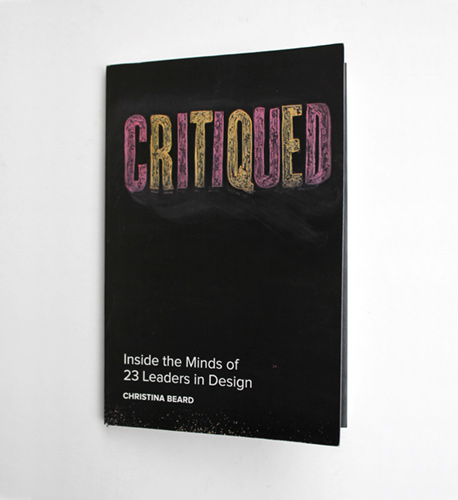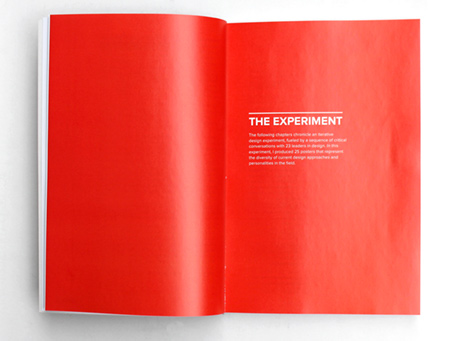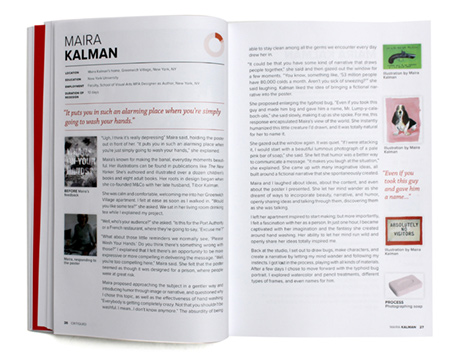Critiqued: 5 Questions with the Author

When fellow Designers Review of Books author Christina Beard contacted me about her new book I was of course very interested to see what one of our own had come up with. The book she has produced however, Critiqued: Inside the Minds of 23 Leaders in Design, was a much more impressive undertaking than I had imagined.
The book is focused on gaining design insight from some of the most well recognized designers in our profession today by constantly iterating on one project based on their input. The results are very interesting and the book provides insight into not only the design process, but just how subjective design really is. I took the time to ask her five questions about the book and just where the idea for the project came from.
Receiving feedback and iterating on work is one of the hardest parts of a designer’s career. What on earth possessed you to go about this experiment?
As a designer, I’ve always been interested in hearing about a designers process rather than the final outcome. For me, seeing visually how someone thinks through an idea can be incredibly interesting.
In traditional graphic design receiving feedback may have been the hardest part of a designers career, but today its part of most designers daily routine. As the design process becomes more transparent its important to know how to interpret and incorporate feedback from an internal team, users, or your client. Designers must be confident in putting their work out there and getting feedback in all phases of the design process.

**What was it like talking to some of the biggest names in the field of design? Were you ever intimidated? **
I never felt intimated. The participants that I met with made it easy for me to feel comfortable and welcome. Many of them expressed interest in the overall process of my project and were curious to see the final outcome.
Before I started this journey I created a set of rules - one of them was to meet with every participant in person. This gave me the opportunity to observe their initial reactions and see how their personalities help shape their views on design.
It was interesting to see Maira Kalman hold the poster up in front of her and then look the other direction as she dreamt up ideas. Or Paula Scher quickly glancing over the poster before rolling it up and explaining that she would never design a poster like that.
I travelled all over the world meeting with designers and usually had only a few days to produce the next poster, it was usually during my travel time that I started to get anxious, wondering how the person would respond to the poster.
The critiques and conversations usually gave me a kind of refuel to move on to the next iteration. Each meeting truly opened me up to a new way of thinking.
If you could travel back in time, who are five deceased designers that you would ask for feedback and why?
Thats a tough question! There are so many living designers that I would like to meet with, let alone designers from the past. But traveling back in time to meet with Charles and Ray Eames would be incredible. I would be so interested in observing how their personalities and collaboration help shape their feedback. Paul Rand is a design legend who created countless iconic brands. It would be fascinating to hear how he would approach this poster.

In the analysis section at the end of the book there is a workshop illustrating a process for approaching design problems. Do you believe that designers should stick to the same process for all of their projects?
Absolutely not. Conversely, the workshop encourages designers to explore and experiment with new approaches and reflects my own journey chronicled in the book.The workshop aims to give students a diverse set of strategies to incorporate or leave out of their own process.
I think its crucial for designers to continually invite new methods into their process in working with clients, brainstorming, and working collaboratively. This project is really a testament that there isn’t one perfect design solution or approach and different methods work for different people.
After everything that you have learned through the process of this project, how important do you feel that it is for clients to be involved with the process and where do you feel that their feedback is most critical?
I enjoy working closely with clients and getting their feedback early and often. In my experience client feedback is most critical in the early stages when a team is researching, ideating and forming a shared vision for whatever they are designing. Of course, there are parts of the process that require designers to focus and work collaboratively with their team, without any client feedback.
To learn more about the book, head over to the Critiqued site here and buy the book from Amazon (US | UK).
[Critiqued has just been named one of the 10 design books of the year by Fast Company – Ed.]
About the Author
Christina Beard is a graphic designer, writer, and sailing enthusiast. She brings design thinking to a range of companies in NYC as a freelance designer. Follow her on Twitter.
About the Reviewer
Dominic Flask is a designer by nature, a teacher by application and a thoughtful companion by friendship. You can view his design portfolio here and his in-progress work on Dribbble.

